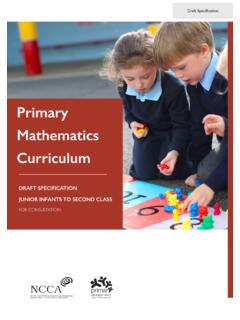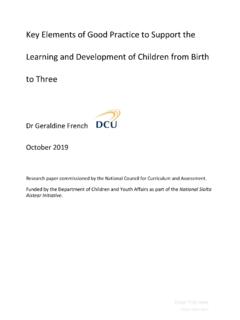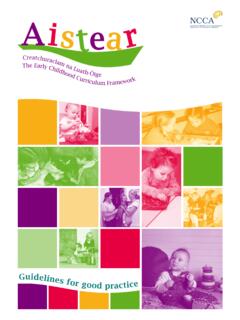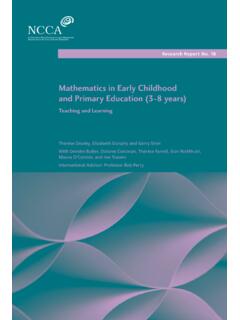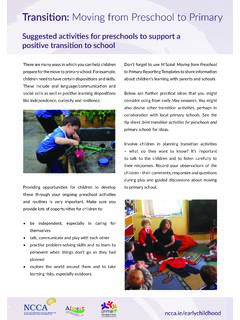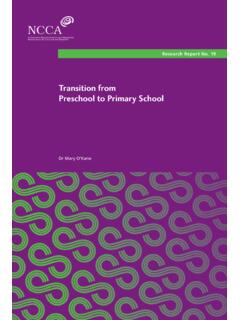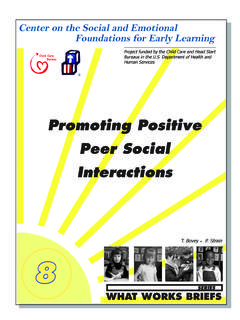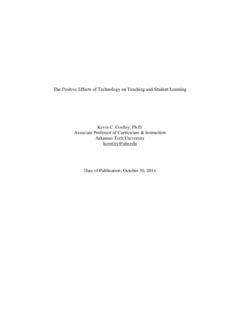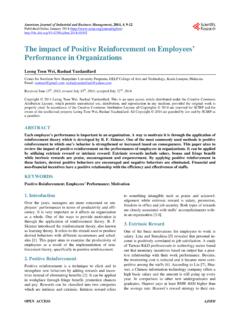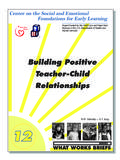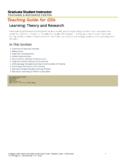Transcription of Helping young children to develop positive learning ...
1 Helping young children to develop positive learning dispositionsTip sheet(3-6 years)Aistear s themes describe what children need to learn from birth onwards and outlines learning in four interconnected aspects: skills, attitudes and values, knowledge and understanding, and dispositions. Skills for children like communicating, mark-making, cutting, climbing, and problem-solving, attitudes and values like respect for themselves and others, care for the environment, and positive attitudes to learning and to life, knowledge and understanding like classifying objects using colour and size, or learning that symbols such as letters or numbers have to Aistear and S olta Aistear Themes: Well-being, Identity and Belonging, Communicating, Exploring and ThinkingGuidelines for good practice.
2 learning and developing through interactions ( ), learning and developing through play ( and 103-106), Supporting learning and development through assessment ( )S olta Standards1: Rights of the Child, , , : Play, : Curriculum, , Digests linked to the above is a disposition ?Aistear defines dispositions as enduring habits of mind and action. A disposition is the tendency to respond to situations in characteristic ways (Aistear, 2009, ). positive dispositions mentioned in Aistear are independence, curiosity, concentration, creativity, responsibility, resilience, patience, perseverance, playfulness, imagination, being interested in things, enjoying problem-solving, being a good listener, assessing and taking risks, being friendly, wanting to communicate, being accepting of others and of differences, being considerate, being happy, cooperating with sheet.
3 Helping young children to develop positive learning can be positive or negative - some dispositions are less helpful than others for children s learning and development. Dispositions are not fixed and they can be encouraged and strengthened, or weakened over time. Practitioners should try to reinforce positive dispositions. For example, children who are never given the opportunity to dress themselves or to tidy up will tend to rely too much on the adult and can develop learned helplessness (a negative disposition ).
4 By encouraging children to be responsible for their own belongings and by getting them to help sweep up or put things in the recycling, practitioners are Helping them to develop the positive dispositions of independence and self-reliance. If a child is naturally anxious and wary of new situations or people, practitioners can encourage the child to be more adventurous and flexible by introducing changes gradually, explaining what will happen before change occurs and by giving lots of also describes children s learning in terms of dispositions that children need in order to achieve their full potential.
5 Dispositions, such as curiosity, independence, resilience, and perseverance are often described as innate or natural character traits that children possess from birth. However, children s inborn dispositions vary and it is important to remember that adult-child interactions and relationships, and the experiences children are exposed to can have an impact on the development of positive learning dispositions. Why are dispositions important? learning dispositions have an impact on a child s overall ability to learn and progress.
6 Dispositions develop alongside and in conjunction with children s acquisition of knowledge, skills, attitudes and understanding. For example, a group of children constructing with wooden blocks are developing the physical skills of grasping, placing and stacking, and learning about shape and size, while at the same time developing the positive disposition of concentration and rejoicing in their problem-solving skills as they build. They may be learning too that we do not always succeed the first time, that we may have to try again and again as the blocks come tumbling down or as another child runs by and collapses their tower, and this helps them to develop the dispositions of patience, perseverance and resilience.
7 Tip sheet: Helping young children to develop positive learning can I encourage positive dispositions? learning dispositions have an impact on a child s overall ability to learn and progress. By being aware of the kind of dispositions that are helpful, practitioners can plan for a supportive environment and interactions that will encourage positive dispositions. For example, $model the disposition $show that you value the disposition $provide opportunities for children to develop dispositions (time, space, equipment or encouragement).
8 $take individual differences and preferences into account, for example by introducing changes gradually, or by giving extra support to a child who needs detail on how you might encourage the development of positive dispositions is outlined independence and resilience: $Provide an environment that enables children to be more independent - accessible storage, picture labels on shelving and boxes, low sinks for hand-washing, low-level coat and apron racks, and space for personal items. $Provide children with tasks to develop responsibility Helping set up activities, turning off lights, distributing drinks, tidying away the props, paints and toys etc.
9 (independence) $Allow children to choose activities and make decisions (at an appropriate level) - Do you want to go inside now or stay outside for a bit longer? (independence) $Wait before you offer help, allow the child time to find a solution, and if there is still a difficulty, ask the child Which part would you like help with? $Suggest strategies and model ways of coping with the inevitable failures and disappointments in life in order to develop resilience - both acknowledging children s feelings and perhaps suggesting an alternative strategy:Dispositions can be encouraged or discouraged, and strengthened or weakened, through experience and through interactions with others and the sheet.
10 Helping young children to develop positive learning $Provide a variety of opportunities to experience and explore different objects and environments, and talk about what you and the children see, feel, and do: -Feel the bark on the cherry tree- it s much smoother and shinier than the oak tree, isn t it? -What s making that noise, I wonder? $Model curiosity, and a willingness to learn: That s an interesting bug you ve found. I don t know what it is. I haven t seen one of those before. I wonder how we could find out more about it?

